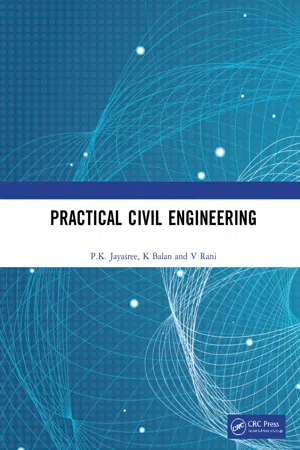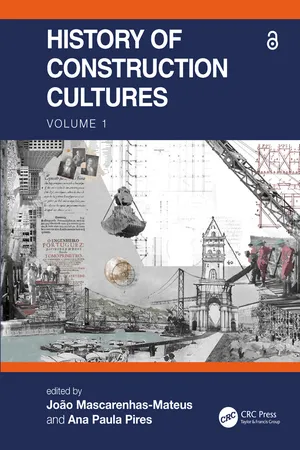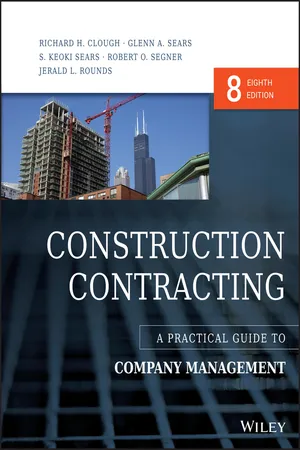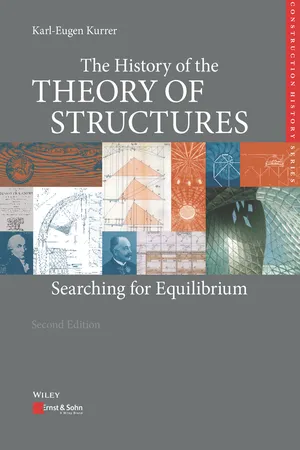Technology & Engineering
Construction Engineering
Construction engineering involves the planning, design, and management of construction projects, ensuring that structures are built safely, efficiently, and within budget. It encompasses various disciplines such as civil, structural, and environmental engineering, and requires expertise in construction materials, methods, and technologies. Construction engineers play a crucial role in overseeing the construction process from inception to completion.
Written by Perlego with AI-assistance
Related key terms
1 of 5
5 Key excerpts on "Construction Engineering"
- eBook - ePub
- P.K. Jayasree, K Balan, V Rani(Authors)
- 2021(Publication Date)
- CRC Press(Publisher)
Construction technology is used for the creation, design, and installation of structures and their different components. The art of building houses, skyscrapers, hospitals, and bridges is included. In addition, the management of construction technology refers to the design, coordination, and successful implementation of such structures. Construction Technology and Management, a branch of civil engineering, gives students an insight into the scientific principles of construction, understanding of the behavior of materials, and the basics of structural mechanism. Construction technologists should have good knowledge of various types of construction materials and test procedures to ensure quality control.8.1.2 Scope of Construction Technology and Management
- Graduates/post-graduates can work as a construction planning engineer and a site engineer in any construction projects in arena of Residential buildings, Cooperatives, huge housing projects, commercial buildings, and hospitals.
- They also estimate the overall project costs and conduct negotiations regarding the elimination of unnecessary scope and cost.
- As managers of quality control, they enforce quality control to reduce potential defects and poor manufacturing.
- Construction managers also optimize and speed up design and planning of works.
8.1.3 Impact of Construction Technology
Construction essentially means building new buildings, residential areas, offices, shopping malls, restaurants, and more. It has a positive and a negative impact on the nation’s growth.8.1.3.1 Positive Construction Impact for a Worker
- High pay scale : Constructors are mostly paid high compared to other workers. In some ways, you are the highest paid worker if you can become a union leader.
- Less working hours : Most IT companies are committed to working for at least 8 hours a day. In the construction sector, however, you are likely to leave earlier than other office workers.
- No need to go formal
- eBook - ePub
History of Construction Cultures Volume 1
Proceedings of the 7th International Congress on Construction History (7ICCH 2021), July 12-16, 2021, Lisbon, Portugal
- João Mascarenhas-Mateus, Ana Paula Pires, João Mascarenhas-Mateus, Ana Paula Pires(Authors)
- 2021(Publication Date)
- CRC Press(Publisher)
The overall purpose of any professional education is to prepare students for entry into their profession. At a minimum, this involves imparting any necessary skillset and essential information. However, the study and application of the professional skills also moulds the way in which students approach challenges, the way they think and what they accept as the norms of their profession. In the case of an engineering degree, the result is to form engineers who are problem solvers with a skillset that includes mathematics and the relevant sciences, and designers with a knowledge of design and construction practice. Engineers must also develop a knowledge of how their profession interfaces with other professions and with society.Civil engineers and structural engineers study structural design, material science and a range of other specialist subjects that are relevant to the design, construction, operation and maintenance of infrastructure. University prepares engineering students for entry to the profession but professional bodies require graduates to practice engineering and work in a variety of roles before they can become chartered Engineers. This recognizes that experience gained through professional practice is necessary to complete the training of a professional engineer. In the case of engineering technicians, the skillset is different but the overall approach to training and professional recognition is similar.Although some aspects of engineering education have changed, many have remained constant since the founding of the École des Ponts et Chaussées in 1747. This commonality of engineering education plus practice leads to a situation where engineers from different backgrounds working in a team have similar viewpoints on what their role comprises and how their goals should be achieved. This shared experience of education and practice could be described as engineering culture. This paper argues that including the study of construction history in engineering programmes will have a positive impact on engineering culture.2 Engineering Culture
The term engineering culture is vague; its meaning has varied over time and with location, and it is not always homogeneous. For example, professional engineers in the United Kingdom during the first half of the 19th century came from a wide variety of backgrounds. Some, like Thomas Telford or George Stephenson, had started as tradesmen whereas others, such as Isambard Kingdom Brunel or John (later Sir John) Rennie, had also had the benefit of a university education (Skempton 2002 , Cross-Rudkin & Chrimes 2008 ). These different backgrounds are reflected in some of the discussions that followed papers that were given to the Institution of Civil Engineers (ICE) at that time, where the contributions offered often reflect the perspective of the contributors (O’Dwyer 2020 ). There was also a difference, or a perceived difference, between the engineering discipline in France and in the UK arising from the different modes of educating and training engineers. Thus, in the past, French engineers might be assumed to lean towards a more scientific view of engineering while engineers from the UK might have viewed themselves as more pragmatic, with an emphasis on practice. These divisions, whether real or imaginary, play into different interpretations of what engineering culture encompasses. However, at the heart of engineering culture there is a kernel of attributes that are widely recognized as being common within the engineering profession, namely: the application of rational techniques and pragmatic numerical models to solve problems. Engineers involved in construction also rely on a knowledge of the properties of the materials used in building and an appreciation of the logistics and economics associated with building work. If an image were to be chosen to represent engineering culture in the 19th century then the painting that hangs in the Institution of Civil Engineers headquarters of Robert Stephenson with his rivals and colleagues in front of the Britannia Bridge would be a strong contender (Figure 1 - eBook - ePub
- Fred Sherratt(Author)
- 2022(Publication Date)
- Routledge(Publisher)
To understand construction management and the role of the construction manager, knowledge of the industry and how it operates is needed. This knowledge provides the background to explain why construction managers do many of the things they do, why they face the problems they do, and how they can ensure that they manage to achieve project success in an effective and efficient way.1.1 What is the 'construction industry'?
The construction industry can be quite complicated to define. There are many different ideas of what the construction industry actually is, and even government departments can spend quite a while trying to explain what they mean at the beginning of their reports about the industry.This is because the construction industry may be looked at from a number of different perspectives, each of which gives a different idea of what it is. For example, the construction industry may be considered by type of work or project:- • New-build construction projects – built from scratch.
- • Refurbishment – repairs or work to change the use of a project; for example, turning an old pub into flats.
- • Demolition work – knocking down part or the whole of an existing project.
Civil engineering is a specialist work activity within the construction industry. It refers to specific types of project such as roads, rail, ports, tunnelling or other types of infrastructure , but civil engineers as professionals also play a role in most construction projects, applying physical and scientific principles to their design and construction.Maintenance of the built environment also falls within the construction industry remit; for example, redecorating domestic properties or replacing roof tiles are both maintenance activities that will be carried out by people working in the construction industry. This has seen the growth of facilities management - eBook - ePub
Construction Contracting
A Practical Guide to Company Management
- Richard H. Clough, Glenn A. Sears, S. Keoki Sears, Robert O. Segner, Jerald L. Rounds(Authors)
- 2015(Publication Date)
- Wiley(Publisher)
civil construction to describe the design and construction of water, gas, and electrical utility lines; telephone distribution facilities; streets; curbs and gutters; storm drains; and so on. Highway and airfield construction refers to clearing, excavation, fill, aggregate production, sub-base and base, paving, drainage structures, bridges, traffic signs, lighting systems, and other such items commonly associated with this type of work.It should be noted that the distinctions between the categories of engineered construction described earlier are not exact. There is a considerable amount of overlap, and some contractors who perform these types of work may refer to themselves with different identifying labels. For example, some highway contractors would routinely include the construction of bridges within their scope of work. Others might award bridge construction to separate contractors or to subcontractors, while some other contractors specialize in the construction of bridges as their primary business. Similarly, some municipal storm drains might be constructed by contractors who refer to themselves as heavy construction contractors, while others performing similar work might call themselves civil construction contractors.Most engineered construction projects of the kind described here are publicly financed, and therefore are also frequently characterized as public construction projects. Projects of the kind described in this section in the aggregate account for approximately 20 to 30 percent of the new construction market.1.5.4 Industrial Construction
Industrial construction includes the erection of projects that are associated with the manufacture or production of an industrial product or service. Such structures are frequently highly specialized and highly technical in nature, and are typically built by large, specialized contracting firms that perform both the design and field construction. Typical examples of this type of construction are petroleum refineries and process plants of all kinds. Almost all of this type of construction is designed by engineers rather than by architects. In addition to an engineer producing the primary design, other engineering firms, and sometimes a variety of consulting firms, assist with specific elements of the design. - eBook - ePub
The History of the Theory of Structures
Searching for Equilibrium
- Karl-Eugen Kurrer, Philip Thrift(Authors)
- 2018(Publication Date)
- Ernst & Sohn(Publisher)
Fig. 3-4 ): “Engineering sciences are not there to serve theory, but practice” [Banse et al., 2006, p. 343]. This also manifests itself in fundamental engineering science disciplines such as applied mechanics and theory of structures because in the end their success is measured in the testing of practical actions. Wolfgang König splits the engineering sciences into product-, function- and occupation-oriented engineering sciences [König, 2006/2, p. 41]. Whereas the product-oriented engineering sciences have evolved from engineering practice and relate to major engineering fields such as construction, mechanical engineering, mining, metallurgy, electrical engineering and computer science, the function-oriented engineering sciences are to a certain extent positioned transverse to these. “Their themes are the functional aspects that are relevant for all or at least a large number of engineering fields and hence also the product-oriented engineering sciences” [König, 2006/2, p. 41]. Therefore, in König’s view, applied mechanics, applied thermodynamics, materials research and theory of structures could be allocated to the function-oriented engineering sciences. On the other hand, the occupation-oriented engineering sciences integrate the knowledge from the product- and function-oriented engineering sciences and present this in the form of courses of study; in addition, they investigate systematically the requirements in the respective occupations and generate specific knowledge databases and methodological procedures for these [König, 2006/2, p. 42]. König lists design, production, environmental technology, quality assurance and industrial engineering among the occupation-oriented engineering sciences [König, 2006/2, p. 42]. Nonetheless, the three categories of product-, function- and occupation-oriented engineering sciences represent an ideal breakdown [König, 2006/2, p. 42]. This is shown by elastic theory, which in the last quarter of the 19th century evolved to become the theoretical basis of strength of materials and classical theory of structures, and influenced both of these fundamental engineering science disciplines until well into the 20th century.FIGURE 3 - 4 Mutual relationships between cognition and design [Banse et al., 2006, p. 344]Among the selected case studies in the Erkennen und Gestalten compendium is one that deals with the practice and science of civil and structural engineering. “Construction theory,” notes Peter Jan Pahl, “is based on the observation that for some areas of building, rules can be established which enable forecasts of the behaviour of structures and components as well as the sequence of building processes” [Pahl, 2006, p. 283]. Construction theory in recent decades has not restricted itself to the physical behaviour of structures and natural systems. Instead, the computer-assisted use of structural mathematics (especially graph theory) for logical tasks in the planning, organisation and management of construction projects plus the utilisation of structures has opened up an important new area that will occupy research and practice for a long time and change the face of civil and structural engineering [Pahl, 2006, pp. 283 – 284]. In their monograph Mathematical Foundations of Computational Engineering
Index pages curate the most relevant extracts from our library of academic textbooks. They’ve been created using an in-house natural language model (NLM), each adding context and meaning to key research topics.




